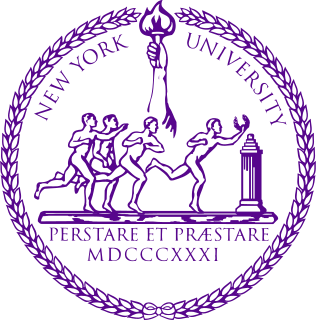
Michael Graves was a noted American architect and designer of consumer products. As well as principal of Michael Graves and Associates and Michael Graves Design Group, he was of a member of The New York Five and the Memphis Group — and professor of architecture at Princeton University for nearly forty years. Following his own partial paralysis in 2003, Graves became an internationally recognized advocate of health care design.
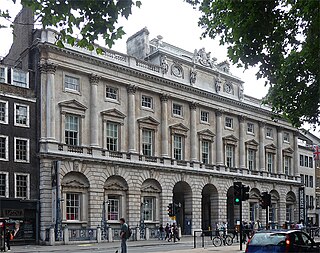
The Courtauld Institute of Art, commonly referred to as The Courtauld, is a self-governing college of the University of London specialising in the study of the history of art and conservation. It is among the most prestigious institutions in the world for these disciplines and is widely known for the disproportionate number of directors of major museums drawn from its small body of alumni.

José Rafael Moneo Vallés is a Spanish architect. He won the Pritzker Prize for architecture in 1996 and the RIBA Royal Gold Medal in 2003.

Guastavino tile is a version of Catalan vault introduced to the United States in 1885 by Valencian (Spanish) architect and builder Rafael Guastavino (1842–1908).
Romaldo "Aldo" Giurgola AO was an Italian academic, architect, professor, and author. Giurgola was born in Rome, Italy in 1920. After service in the Italian armed forces during World War II, he was educated at the Sapienza University of Rome. He studied architecture at the University of Rome, completing the equivalent of a B.Arch. with honors in 1949. That same year, he moved to the United States and received a master's degree in architecture from Columbia University. In 1954, Giurgola accepted a position as an assistant professor of architecture at the University of Pennsylvania. Shortly thereafter, Giurgola formed Mitchell/Giurgola Architects in Philadelphia with Ehrman B. Mitchell in 1958. In 1966, Giurgola became chair of the Columbia University School of Architecture and Planning in New York City, where he opened a second office of the firm. In 1980 under Giurgola's direction, the firm won an international competition to design a new Australian parliament building. Giurgola moved to Canberra, Australia to oversee the project. In 1989, after its completion and official opening in 1988, the Parliament House was recognized with the top award for public architecture in Australia.
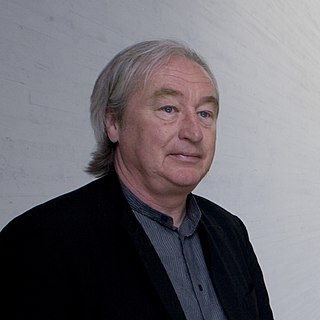
Steven Holl is a New York-based American architect and watercolorist. Among his most recognized works are designs for the 2003 Simmons Hall at MIT in Cambridge, Massachusetts, the 2007 Bloch Building addition to the Nelson-Atkins Museum of Art in Kansas City, Missouri, and the 2009 Linked Hybrid mixed-use complex in Beijing, China.
Henry-Russell Hitchcock (1903–1987) was an American architectural historian. A long-time professor at Smith College and New York University, his writings helped to define modern architecture.
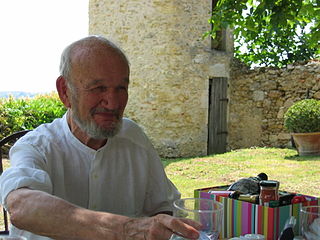
Norval Crawford White was an American architect, architectural historian and professor. He designed buildings throughout the U.S., but he is best known for his writing, particularly the AIA Guide to New York City. White was widely considered to be one of the great figures of New York architecture.

Beck University was a web-based education program launched in July 2010 by American radio and television host Glenn Beck's Mercury Radio Arts. Beck University offered online classes in subjects such as religion, American history, and economics. The classes were offered to anyone who subscribes to Beck's TheBlaze.
Patrick J. Geary is an American medieval historian and Professor of Western Medieval History at the Institute for Advanced Study in Princeton, New Jersey. He also holds the title of Distinguished Professor of Medieval History Emeritus at the University of California, Los Angeles.
Ahmed Cemal Eringen was a Turkish- American engineering scientist. He was a professor at Princeton University and the founder of the Society of Engineering Science. The Eringen Medal is named in his honor.
George Joseph Ranalli is an American modernist architect, scholar, curator, and fellow of the American Institute of Architects. He is based in New York City.

Jean-Louis Cohen is a French architect and architectural historian specializing in modern architecture and city planning. Since 1994 he has been the Sheldon H. Solow Professor in the History of Architecture at New York University Institute of Fine Arts.

Marlon Blackwell is an American architect and university professor in Arkansas. A Fellow of the American Institute of Architects, Blackwell is the E. Fay Jones Chair in Architecture and a Distinguished Professor in the Fay Jones School of Architecture and Design at the University of Arkansas in Fayetteville. He is founder and principal at Marlon Blackwell Architects, a design firm established in 2000 in Fayetteville. Working outside the architectural mainstream, his architecture is based in design strategies that celebrate vernaculars and that draw upon them, and that seek to transgress conventional boundaries for architecture.
Mario I. Gandelsonas is an American architect and theorist whose specializations include urbanism and semiotics.
Lauretta Vinciarelli was an artist, architect, and professor of architecture at the collegiate level.
Robert Louis Geddes, is an American architect, planner, writer, educator, former principal of the firm Geddes Brecher Qualls Cunningham (GBQC), and dean emeritus of the Princeton University School of Architecture (1965-1982). As principal of GBQC, select major projects include Pender Labs at the Moore School of Electrical Engineering, University of Pennsylvania, the Philadelphia Police Headquarters, the Liberty State Park master plan, the Philadelphia Center City master plan, and his best-known work, the Dining Commons, Birch Garden, and Academic Building at the Institute for Advanced Study. He is a Fellow of the American Institute of Architects; recipient of honorary doctorates from Princeton University, City College of New York, and the New Jersey School of Architecture/NJIT; recipient of the Topaz Award from the American Institute of Architects and the Association of Collegiate Schools of Architecture, and, along with his firm, is the recipient of the Architecture Firm Award.
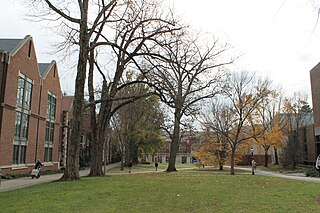
Princeton University School of Architecture is one of the world's leading and most prestigious architecture schools. Founded in 1919, the School is a center for teaching and research in architectural design, history, and theory at Princeton University. The School offers offers an undergraduate certificate and advanced degrees at the master's and doctoral levels.

Charles Herbert Moore was an American university professor, painter, and architectural historian, known as the first director of Harvard University's Fogg Art Museum. He was one of many followers of the works of John Ruskin, and was known as an American Pre-Raphaelite. In 1871, Moore left painting to begin teaching at Harvard, where he led its new art department. There Moore was among the first art historians at an academic institution in the United States. After retirement, Moore moved to Hampshire, England. He wrote many books on medieval and Renaissance architecture there, and died in Hampshire in 1930.



